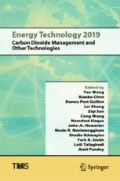Abstract
Phosphorus (P) is widely used as n-type dopant for silicon (Si) to form the emitter layer in wafer-based silicon solar cells . The main purpose of this work is to investigate the influence of P doping on the structural and mechanical properties of silicon . CASTEP program, which uses the density functional theory (DFT), with a plane-wave basis, is used to study the structural, electronic, and mechanical properties of undoped and P-doped Si (Si1−xPx for 0.0001 ≤ x ≤ 0.05). The density of states (DOS), band structure, elastic constants, bulk modulus \( \left( B \right) \), Young’s modulus (E), Shear modulus \( \left( G \right) \), and Poisson’s ratio (v) were all calculated. It is found that brittleness of Si increased by P doping .
Access this chapter
Tax calculation will be finalised at checkout
Purchases are for personal use only
References
Pfrommer BG, Cộté M, Louie SG, Cohen ML (1997) Ab initio study of silicon in the R8 phase. Phys Rev B 56(15):6662–6668
Bernstein N, Mehl MJ, Papaconstantopoulos DA (2000-I) Energetic, vibrational, and electronic properties of silicon using a nonorthogonal tight-binding model. Phys Rev B 62(7):4477–4487
Güler E, Güler M (2013) Geometry optimization calculations for the elasticity of gold at high pressure. Adv Mater Sci Eng 2013:525673
Pi Xiaodong (2012) Doping silicon nanocrystals with boron and phosphorus. J Nanomater 2012:912903
Segall MD, Lindan PJD, Probert MJ, Pickard CJ, Hasnip PJ, Clark SJ, Payne MC (2002) First-principles simulation: ideas, illustrations and the CASTEP code. J. Phys. Condens. Mater. 14:2717–2744
Zhu W, Xiao H (2008) Ab initio study of electronic structure and optical properties of heavy-metal azides: TlN3, AgN3, and CuN3. J Comput Chem 29:176–184
Perdew JP, Burke K, Ernzerhof M (1996) Generalized gradient approximation made simple. Phys Rev Lett 77(18):3865–3868
Perdew JP, Chevary JA, Vosko SH, Jackson KA, Pederson MR, Singh DJ, Fiolhais C (1992) Atoms, molecules, solids, and surfaces: applications of the generalized gradient approximation for exchange and correlation. Phys Rev B 46:6671–6687
Vanderbilt D (1990) Soft self-consistent pseudopotentials in a generalized eigenvalue formalism. Phys Rev B 41(11):7892–7895
Bellaiche L, Vanderbilt D (2000) Virtual crystal approximation revisited: application to dielectric and piezoelectric properties of perovskites. Phys Rev B 61(12):7877–7882
Monkhorst HJ, Pack JD (1976) Special points for Brillouin-zone integrations. Phys Rev B 13(12):5188–5192
Wortman JJ, Evans RA (1965) Youngs’ modulus, shear modulus and Poisson’s ratio in silicon and germanium. J Appl Phys 36:153–156
Staroverov VN, Scuseria GE, Tao J, Perdew JP (2004) Tests of a ladder of density functionals for bulk solids and surfaces. Phys Rev B 69:075102
Kittel C (1996) Introduction to solid state physics, 7th edn. Wiley, New York
Haas Philipp, Tran Fabien, Blaha Peter (2009) Calculation of the lattice constant of solids with semilocal functionals. Phys Rev B 79:085104
Pugh SF (1954) XCII. Relations between the elastic moduli and the plastic properties of polycrystalline pure metals. Philos Mag 45:823–843
Hébert C, Luitz J, Schattschneider P (2003) Improvement of energy loss near edge structure calculation using Wien2k. Micron 34:219–225
Hybertsen MS, Louie SG (1986) Electron correlation in semiconductors and insulators: band gaps and quasiparticle energies. Phys Rev B 34:5390–5413
Prikhodko M, Miao MS, Lambrecht WRL (2002) Pressure dependence of sound velocities in 3C-SiC and their relation to the high-pressure phase transition. Phys Rev B 66:125201
Güler E, Güler M (2015) Elastic and mechanical properties of cubic diamond under pressure. Chin J Phys 53(2):040807
Schall JD, Gao G, Harrison JA (2008) Elastic constants of silicon materials calculated as a function of temperature using a parametrization of the second-generation reactive empirical bond-order potential. Phys Rev B 77:115209
Mayer B, Anton H, Bott E, Methfessel M, Sticht J, Harris J, Schmidt PC (2003) Ab-initio calculation of the elastic constants and thermal expansion coefficients of Laves phases. Internet 11:23–32
Evecen M, Ciftci YO (2017) First-principles study on the structural, elastic, electronic and vibrational properties of scandium based intermetallic compounds (ScX, X = Co, Rh and Ir) under pressure. J Nanoelectron Optoelectron 12:100–108
Güler E, Güler M (2014) Phase transition and elasticity of gallium arsenide under pressure. Mater Res Ibero Am J 17(5):1268–1272
Bensalem S, Chegaar M, Maouche D, Bouhemadou A (2014) Theoretical study of structural, elastic and thermodynamic properties of CZTX (X = S and Se) alloys. J Alloy Compd 589:137–142
Fatima B, Chouhan SS, Acharya N, Sanyal SP (2014) Theoretical prediction of the electronic structure, bonding behavior and elastic moduli of scandium intermetallics. Internet 53:129–139
Güler M, Güler E (2013) Embedded atom method-based geometry optimization aspects of body-centered cubic metals. Chin Phys Lett 30(5):056201
Guo Y, Wang Q, Kawazoe Y, Jena P (2015) A New silicon phase with direct band gap and novel optoelectronic properties. Sci Rep 5:14342
Anderson HL (ed) (1989) A Physicist’s desk reference, The second edition of physics Vade Mecum. American Institute of Physics, New York
George A (1997) Elastic constants and moduli of diamond cubic Si. In: Hull R (ed). Properties of crystalline silicon 20, EMIS Data reviews, INSPEC, IEE, London, pp 98–103
Author information
Authors and Affiliations
Corresponding author
Editor information
Editors and Affiliations
Rights and permissions
Copyright information
© 2019 The Minerals, Metals & Materials Society
About this paper
Cite this paper
Ikhmayies, S., Çiftci, Y.Ö. (2019). The Influence of Phosphorus Dopant on the Structural and Mechanical Properties of Silicon. In: Wang, T., et al. Energy Technology 2019. The Minerals, Metals & Materials Series. Springer, Cham. https://doi.org/10.1007/978-3-030-06209-5_21
Download citation
DOI: https://doi.org/10.1007/978-3-030-06209-5_21
Published:
Publisher Name: Springer, Cham
Print ISBN: 978-3-030-06208-8
Online ISBN: 978-3-030-06209-5
eBook Packages: Chemistry and Materials ScienceChemistry and Material Science (R0)

